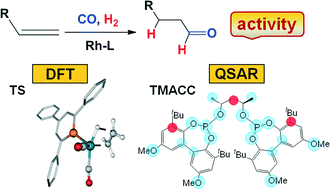A theoretical study of the activity in Rh-catalysed hydroformylation: the origin of the enhanced activity of the π-acceptor phosphinine ligand†
Abstract
The factors governing the activity in Rh-catalyzed hydroformylation were investigated using a set of computational tools. We performed DFT calculations on the phosphinine-modified Rh catalyst [HRh(CO)3(PC5H2R3)] and compared it to the phosphane-modified HRh(CO)3(PR3) and HRh(CO)2(PR3)2 complexes. The π-acceptor phosphinine ligand coordinates preferentially at the equatorial site of the pentacoordinated Rh complex with the heterocycle perpendicular to the equatorial plane, although the ligand freely rotates around the Rh–P bond. The overall energy barrier can be divided into the following contributions: alkene complex formation, alkene rotation and alkene insertion. In the absence of steric effects (model systems), the overall barrier correlates with the computed barrier for alkene rotation. This proves that π-acceptor ligands reduce back-donation to the alkene, leading to a lower rotational barrier and, consequently, to a higher activity. The Rh–P donor–acceptor interactions were quantified using a modified version of energy decomposition analysis (EDA). In Rh–phosphinine systems, the efficient directionality of the π-back-donation, rather than the overall acceptor ability, is responsible for the high catalytic activity. Introducing steric effects increases the energy required to coordinate the alkene, increasing the overall barrier. The factors governing the activity in Rh–monophosphane catalysts seem to be related to those derived for Rh–diphosphane during the development of a QSAR model (Catal. Sci. Technol. 2012, 2, 1694). To investigate whether the findings for mono- can be extrapolated to diphosphane ligands, we re-examined our previous QSAR model using the Topological Maximum Cross Correlation (TMACC) method based on easy-to-interpret 2D-descriptors. The TMACC descriptors highlight heteroatoms close to phosphorus as activity-increasing atoms, whereas highly substituted carbon atom groups are highlighted as activity-decreasing groups.


 Please wait while we load your content...
Please wait while we load your content...